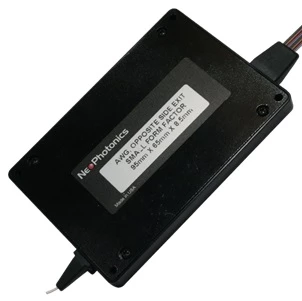Description
The Periodically Poled Lithium Niobate (PPLN) Waveguide represents a significant advancement in the field of nonlinear optical devices. This waveguide is crafted using advanced techniques such as the proton exchange method and metal diffusion method, which are renowned for their efficacy in preparing lithium niobate waveguides. These methods, however, traditionally result in a small refractive index difference between the waveguide and the substrate layer, leading to a weaker light confinement capability. Additionally, the introduction of foreign ions during these processes can potentially alter the intrinsic properties of the lithium niobate crystal, impacting the waveguide's overall performance.
To address these challenges, the PPLN Waveguide utilizes a ridge waveguide structure based on lithium niobate single crystal film (LNOI). This innovative design significantly enhances the refractive index difference between the core and the shell of the waveguide. As a result, the optical limiting effect is improved, thereby enhancing the nonlinear optical effects of the lithium niobate waveguide. This improvement is crucial for applications requiring high efficiency and stability.
Moreover, the lithium niobate ridge waveguide boasts a higher optical damage threshold, making it particularly suitable for high-power frequency conversion devices. This characteristic ensures that the waveguide can handle intense optical powers without compromising its structural integrity or performance, making it an ideal choice for cutting-edge optical applications.
PPLN Waveguide
Specifications
| Insertion Loss (max): | 4 dB |
|---|---|
| Input Wavelength: | 1560 nm |
| Output Wavelength: | 780 nm |
| Output Power: | 2 W |
| Polarization Extinction Ratio (PER): | ≥20 dB |
| NTC Impedance @ 25℃: | 10 kΩ |
| Operating Temperature: | 10~+35 ℃ |
| Storage Temperature: | -20~+70 ℃ |
| Input/Output Fiber: | PM1550+PM780 |
Features
- Available for SHG/SFG/DFG Nonlinear Frequency Conversion: The PPLN waveguide supports second harmonic generation (SHG), sum frequency generation (SFG), and difference frequency generation (DFG) for versatile applications.
- High Efficiency Coupling: Achieves excellent coupling efficiency between optical fiber and waveguide, ensuring optimal performance.
- High Conversion Efficiency: Designed to maximize the conversion efficiency for effective frequency conversion processes.
- High Damage Threshold: Built to withstand high power levels, making it suitable for demanding applications.
- High Long-Term Stability: Ensures reliable performance over extended periods, maintaining consistent output.
Applications
- High Power Single Frequency Laser: Ideal for applications requiring precise and powerful laser outputs.
- Quantum Key Distribution System: Supports secure communication systems through quantum key distribution.
- Laser Radar: Enhances the performance of laser radar systems for accurate detection and ranging.
- Optical Sensing: Suitable for advanced optical sensing applications requiring high sensitivity and accuracy.
Frequently Asked Questions
What is the PPLN Waveguide used for?
What are the key features of the PPLN Waveguide?
How is the PPLN Waveguide prepared?
What is the output power curve of the high power 1560nm SHG WG?
What are the general specifications of the PPLN Waveguide?
Similar Products
Your inquiry has been received.
Create an account by adding a password
Why create an account?
- Auto-complete inquiry forms
- View and manage all your past messages
- Save products to your favorites
- Close your account anytime — no hassle

